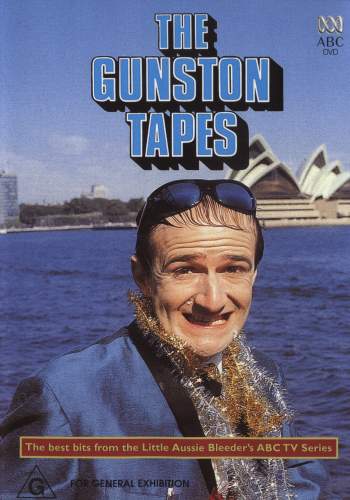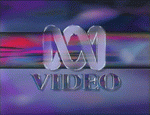The Gunston Tapes (1991) |
|
The Gunston Tapes (1991) |
|


|
| BUY IT |
| General | Extras | ||
| Category | Comedy | None | |
| Rating |

|
||
| Year Of Production | 1991 | ||
| Running Time | 103:35 (Case: 102) | ||
| RSDL / Flipper | No/No | Cast & Crew | |
| Start Up | Ads Then Menu | ||
| Region Coding | 1,2,3,4,5,6 | Directed By | John Eastway |
|
Studio
Distributor |
 Roadshow Home Entertainment |
Starring | Garry McDonald |
| Case | Amaray-Transparent-Secure Clip | ||
| RPI | $24.95 | Music | None Given |
| Video | Audio | ||
| Pan & Scan/Full Frame | Full Frame | English Dolby Digital 2.0 (224Kb/s) | |
| Widescreen Aspect Ratio | 1.29:1 | ||
| 16x9 Enhancement | No | ||
| Video Format | 576i (PAL) | ||
| Original Aspect Ratio | 1.29:1 | Miscellaneous | |
| Jacket Pictures | No | ||
| Subtitles | None | Smoking | Yes |
| Annoying Product Placement | No | ||
| Action In or After Credits | Yes | ||
It's easy to dismiss Garry McDonald's Norman Gunston character as an early and unsophisticated precursor to modern characters such as Ali G. A loser who's overwhelmed by the sketch/interview show he's been given, Gunston established the ignorant-comedy interview style on The Aunty Jack Show. Portraying a local "roving reporter" for What's on in Wollongong, Gunston staged in-depth interviews with people he'd met on the bus that day and in 1973, when Aunty Jack ripped her last arm off, Gunston was given his own Sunday night half-hour to fill.
Gunston's format included a mixture of music and sketches, but his interviews were the cornerstone of the show. Gunston's naive line of questioning and the novelty (at the time) of an interviewer asking ludicrous questions in a deadpan manner allowed him to get away with asking Paul McCartney whether there was any truth to the rumour that he was dead, or Muhammad Ali whether there was any chance that he and Joe Frazier could shake hands and make up. Interviewees' responses varied wildly - some stumbled onto the joke fairly early and played along. Others tried patience. Some merely got insulted and started lecturing or insulting the hapless interviewer. Keith Moon, in all fairness, had tipped a bottle of vodka over Gunston's head before he even had a chance to ask a question.
The Gunston Tapes is a shade over 100 minutes of selected highlights from the show. All are in colour - and may have been selected partially based on this factor, considering that broadcasts were still made in black and white for the first two of Gunston's series - and represent at least brief tastes of most of the show's best moments. The famous Kiss interview where Gunston explained in detail to Gene Simmons how a relative had managed to grow a tongue substantially longer than that of the guitarist is missing, and I would have liked to have seen much more of Gunston's presence at Parliament House on the day of Gough Whitlam's dismissal. There is also substantial representation of celebrities who have faded into the ether, and not all are properly introduced. Part of this may be that I'm simply too young to remember them, but the relevance of guests such as Father Jim McLaren has long since passed into nostalgia. That said, much that is here is excellent, especially interviews with Sally Struthers, Paul and Linda McCartney and Ray Charles, and fans who remember the series and the time will find enough here to satisfy them. It is worth noting that the four photos used on the disc case, however, are not from sketches or interviews present on the disc.
The ABC's classic TV disc production makes a habit of producing quite reasonable digital transfers of source material which can get quite awful at times, and this is no exception. The discs (perhaps understandably, being taken from TV produced over 30 years ago and reprocessed for video in 1991) could be used as reference material for almost every possible analogue artefact, but despite fitting over 100 minutes onto a single-layered disc, there was no detectible digital artefacting.
The feature is presented in its original format and is not 16x9 enhanced.
The original recordings vary greatly in quality from piece to piece, and even between cameras in the same item. Grain is particularly bad in many of the items, and can become quite distracting at times. Lighting is often poor and shadows are usually impenetrable. Lines are quite fuzzy and there is substantial colour bleeding at times.
Colour is continually a problem, with most pieces over the course of this feature being either washed out or oversaturated.
While there is no obvious problem with digital transfer artefacts, almost every other film and video artefact is here. Analogue tape tracking is often a problem, as is low level and chroma noise. Film artefacts are abundant in every scene and microphony occurs even at quite low sound levels. All over-screen displays are subject to over or undermodulation, even both in the case of the closing credits where the gain appears to have started too low and then been turned up too high. Lens flare occurs regularly on location shooting, and when Gunston takes a photo of Edward Woodward and Michelle Dotrice at 33:29, the camera flash leaves a comet trail-style mark on one camera for well over a minute. Telecine wobble occurs frequently (although never to too great a degree), and while splice marks aren't obvious, several times there is splice-related writing over the original film that has been transferred quite happily through to the disc.
There is no subtitle track on this disc.
The disc is single-layered, requiring no layer change.
| Sharpness | |
| Shadow Detail | |
| Colour | |
| Grain/Pixelization | |
| Film-To-Video Artefacts | |
| Film Artefacts | |
| Overall |
The audio quality is generally adequate, although there are some cases where the studio audience's laughter obscures the dialogue, and when on location the microphone tends to pick up wind noise, especially at and around 21:00 when Gunston's nearby helicopter causes substantial wind popping.
The single audio track is encoded to Dolby Digital stereo, but belies its mono roots as both channels present the same track, effectively producing a wider mono stagefront.
The dialogue is generally adequately recorded, especially in studio pieces, but can be obscured by the audience noise at times and is not consistent on location.
Music is sparse, but adequately presented, especially for Gunston's in-studio musical numbers.
Surround channels are not used.
The subwoofer was not used throughout the disc, even during the in-studio musical numbers.
| Dialogue | |
| Audio Sync | |
| Clicks/Pops/Dropouts | |
| Surround Channel Use | |
| Subwoofer | |
| Overall |
No extras were presented on this disc.
NOTE: To view non-R4 releases, your equipment needs to be multi-zone compatible and usually also NTSC compatible.
We have not been able to find any other release of this disc globally.
A brief, but enjoyable taste of the original run of The Norman Gunston Show, hampered by poor source material.
| Video | |
| Audio | |
| Extras | |
| Plot | |
| Overall |
| Review Equipment | |
| DVD | Pioneer DV-535, using S-Video output |
| Display | Panasonic TX-86PW300A. This display device is 16x9 capable. |
| Audio Decoder | Pioneer VSX-512. |
| Amplification | Pioneer VSX-512 |
| Speakers | Wharfedale Diamond 8.3 fronts, Wharfedale Diamond 8.2 rears, Wharfedale Diamond 8 centre, Wharfedale 12" sub |